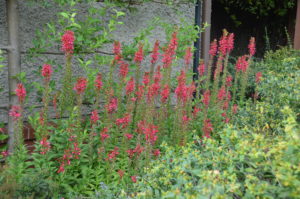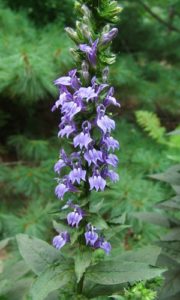Great lobelia or blue cardinal flower (Lobelia siphilitica) is a native perennial USDA hardiness zones 4-8). They bloom about a month later than cardinal flower (Lobelia cardinalis). They’re part of the late summer perennial bloom season that includes turtlehead (Chelone obliqua), asters (Symphtrictum), ‘Henry Eilers’ black eyed Susan (Rudbeckia subtomentosa). and dahlias (Dahlia spp.). Add this clump-forming perennial to a perennial border or woodland garden.
The erect 2-3 feet, stems produce lavender-blue, tubular flowers crowded together on the upper stem. Showy, bright blue flowers are in the axils of leafy bracts and form an elongated cluster on a leafy stem. Each flower is split into two lips – the upper lip has two segments and the lower lip has three. Flowers form a dense terminal raceme atop stiff, unbranched leafy stalks, typically rising 2-3 feet tall. Finely-toothed, lance-shaped, light green 5-inch long leaves are attached to the flower stem.
In the wild you see both red cardinal flower and great lobelia growing in wet soils. A garden plant want a humus- rich, medium to wet soils and full sun to part shade. It is tolerant of acid to neutral (pH 5.2-7.0). They demand almost constant moisture, but great blue lobelia tolerates drier sites and more shade. Immerse them in your bog or water garden. Both tolerate full sun in cool, northern climates, but otherwise appreciates part shade in southern climes. In a wetland habitat plants may self-seed in optimum site and form attractive colonies.
Planting both species create a stunning show. Hummingbirds will come and visit.
Both plant species are generally short-lived. For longevity a 2-3 year old plant clump should be lifted and divided in the spring. No disease or insect problems trouble this native plant. Snails and slugs may damage the foliage.



 Posted in
Posted in 
